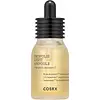What's inside
What's inside
 Key Ingredients
Key Ingredients

 Benefits
Benefits

 Ingredients Side-by-side
Ingredients Side-by-side

Water
Skin ConditioningGlycerin
HumectantPropanediol
SolventBetaine
HumectantNiacinamide
Smoothing1,2-Hexanediol
Skin ConditioningDicaprylyl Ether
EmollientDicaprylyl Carbonate
EmollientPentylene Glycol
Skin ConditioningPolyglyceryl-10 Laurate
Skin ConditioningLaminaria Japonica Extract
Skin ProtectingEclipta Prostrata Leaf Extract
Skin ConditioningGlycyrrhiza Uralensis Root Extract
Skin ConditioningSciadopitys Verticillata Root Extract
AntimicrobialSalvia Miltiorrhiza Root Extract
Skin ConditioningDioscorea Japonica Root Extract
Skin ConditioningTheobroma Cacao Seed Extract
AntioxidantPiper Methysticum Leaf/Root/Stem Extract
Skin ConditioningCentella Asiatica Extract
CleansingPanax Ginseng Berry Extract
Skin ConditioningHydrogenated Lecithin
EmulsifyingMethylpropanediol
SolventAcrylates/C10-30 Alkyl Acrylate Crosspolymer
Emulsion StabilisingXanthan Gum
EmulsifyingTromethamine
BufferingAdenosine
Skin ConditioningFructooligosaccharides
HumectantBeta-Glucan
Skin ConditioningDextrin
AbsorbentPolyquaternium-51
Skin ConditioningHydrolyzed Hyaluronic Acid
HumectantSaccharide Isomerate
HumectantButylene Glycol
HumectantGlycosphingolipids
EmollientPhospholipids
Skin ConditioningGlycine
BufferingGlutamic Acid
HumectantLeucine
Skin ConditioningSerine
MaskingAspartic Acid
MaskingLysine
Skin ConditioningMethionine
Skin ConditioningValine
MaskingSodium Citrate
BufferingCysteine
AntioxidantCitric Acid
BufferingIsoleucine
Skin ConditioningAlanine
MaskingArginine
MaskingCholesterol
EmollientTyrosine
MaskingThreonine
Phenylalanine
MaskingProline
Skin ConditioningHistidine
HumectantEthylhexylglycerin
Skin ConditioningWater, Glycerin, Propanediol, Betaine, Niacinamide, 1,2-Hexanediol, Dicaprylyl Ether, Dicaprylyl Carbonate, Pentylene Glycol, Polyglyceryl-10 Laurate, Laminaria Japonica Extract, Eclipta Prostrata Leaf Extract, Glycyrrhiza Uralensis Root Extract, Sciadopitys Verticillata Root Extract, Salvia Miltiorrhiza Root Extract, Dioscorea Japonica Root Extract, Theobroma Cacao Seed Extract, Piper Methysticum Leaf/Root/Stem Extract, Centella Asiatica Extract, Panax Ginseng Berry Extract, Hydrogenated Lecithin, Methylpropanediol, Acrylates/C10-30 Alkyl Acrylate Crosspolymer, Xanthan Gum, Tromethamine, Adenosine, Fructooligosaccharides, Beta-Glucan, Dextrin, Polyquaternium-51, Hydrolyzed Hyaluronic Acid, Saccharide Isomerate, Butylene Glycol, Glycosphingolipids, Phospholipids, Glycine, Glutamic Acid, Leucine, Serine, Aspartic Acid, Lysine, Methionine, Valine, Sodium Citrate, Cysteine, Citric Acid, Isoleucine, Alanine, Arginine, Cholesterol, Tyrosine, Threonine, Phenylalanine, Proline, Histidine, Ethylhexylglycerin
 Reviews
Reviews

Ingredients Explained
These ingredients are found in both products.
Ingredients higher up in an ingredient list are typically present in a larger amount.
1,2-Hexanediol is a synthetic liquid and another multi-functional powerhouse.
It is a:
- Humectant, drawing moisture into the skin
- Emollient, helping to soften skin
- Solvent, dispersing and stabilizing formulas
- Preservative booster, enhancing the antimicrobial activity of other preservatives
Arginine is an amino acid that is important for human development. Your body uses is it to produce hair keratin and skin collagen.
As a cosmetic ingredient, Arginine has antioxidant properties and can also help repair damaged skin. This ingredient is derived either synthetically or from animals.
Arginine isn't fungal acne safe when used in the presence of other lipids (fats, fatty acids, oils, esters, etc). Oils and fats occur naturally within the skin, so take caution when using Arginine if you're prone to fungal acne.
Learn more about ArginineBetaine is a common humectant (a substance that promotes retention of moisture). It's known to be gentle on the skin and can help balance hydration.
This ingredient is best for improving hydration and soothing irritated skin. Studies also show it helps even out skin tone.
Fun fact: Betaine is naturally created in the skin and body. The kind found within cosmetic products can be either plant-derived or synthetic.
Another name for betaine is trimethylglycine.
Learn more about BetaineButylene Glycol (or BG) is used within cosmetic products for a few different reasons:
Overall, Butylene Glycol is a safe and well-rounded ingredient that works well with other ingredients.
Though this ingredient works well with most skin types, some people with sensitive skin may experience a reaction such as allergic rashes, closed comedones, or itchiness.
Learn more about Butylene GlycolGlycerin is already naturally found in your skin. It helps moisturize and protect your skin.
A study from 2016 found glycerin to be more effective as a humectant than AHAs and hyaluronic acid.
As a humectant, it helps the skin stay hydrated by pulling moisture to your skin. The low molecular weight of glycerin allows it to pull moisture into the deeper layers of your skin.
Hydrated skin improves your skin barrier; Your skin barrier helps protect against irritants and bacteria.
Glycerin has also been found to have antimicrobial and antiviral properties. Due to these properties, glycerin is often used in wound and burn treatments.
In cosmetics, glycerin is usually derived from plants such as soybean or palm. However, it can also be sourced from animals, such as tallow or animal fat.
This ingredient is organic, colorless, odorless, and non-toxic.
Glycerin is the name for this ingredient in American English. British English uses Glycerol/Glycerine.
Learn more about Glycerin